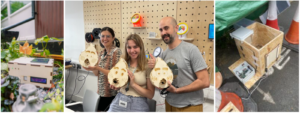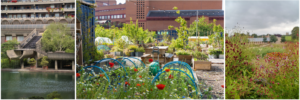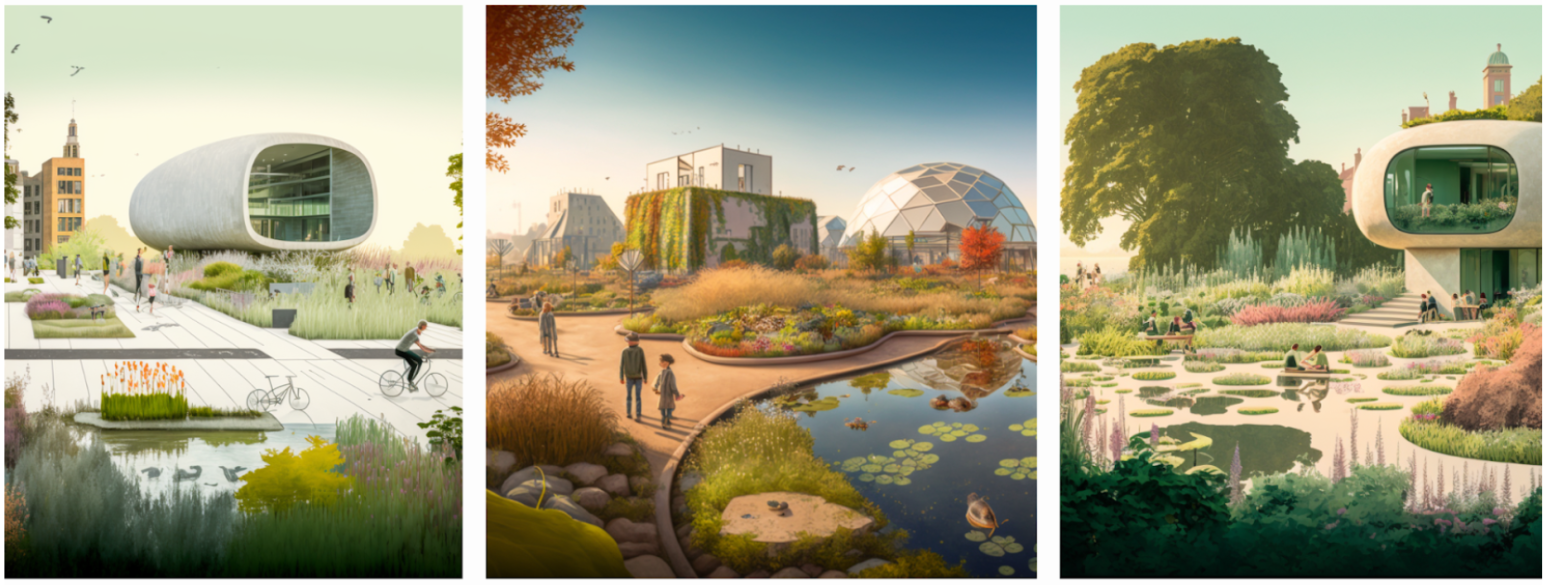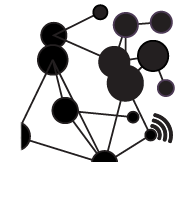Hello, I am Aude, a Nature Engineer pursuing my PhD research in “Gardens of Things”. My time is split between the Connected Environment Lab under the primary supervision of Prof. Duncan Wilson and the People and Nature Lab under the secondary supervision of Prof. Kate Jones. My PhD investigates how the use of Internet of Things (IoT) sensor networks and Edge AI can help monitor and evaluate the socio-ecological systems and environmental processes of urban green spaces.
In this blog post, I will share why there is a growing interest in combining computer science and ecology, how my research fits within the CE Lab, and three of the projects I am engaging with. To learn more about my educational path that brought me from Switzerland to London, you can read my blog post “A Journey between ETH Zurich and UCL”.
What is my research, and why is it important?
As a prospective student of the Center for Advanced Spatial Analysis (CASA), concepts such as “Smart Cities”, spatial computing, digital twins, or sensor systems are probably all too familiar. The increasing number of people moving towards urban centres has led to rapid growth in cities, which has created pressures on the functioning of cities. Today, many cities have integrated internet-connected sensor devices to monitor and manage various layers of the city. Continuously collected and up-to-date information about urban systems such as transport, energy, water supply, building infrastructure, and government services is crucial in order to efficiently manage the city.
But for cities to be highly liveable, the “smartness” of their infrastructure and government services is not the only ingredient. Nature plays a key role. Nature’s importance can be seen in various city rankings. The Economist Intelligence Unit’s Global Liveability Index gives a 25% weight to the Culture & Environment category, the Arcadis Sustainable Cities Index gives one-third of its weight to categories related to planetary health, and the Monocle Quality of Life Survey evaluates access to nature, environmental issues, climate, and urban design. Nature in urban areas matters.
Today, when mayors are thinking about improving the liveability of their cities, nature is part of the discussion. Whether in the form of green infrastructure such as parks, allotments, street trees, green roofs, or blue infrastructure such as wetlands, canals or river banks, nature brings a multiplicity of benefits. It helps cities with climate regulations, provides humans with space for physical activity and social interactions, and supports ecological connectivity and ecosystem function. While climate scientists declared that the planet is in a state of climate emergency and ecologists pointed to the severe decline in biodiversity (as tracked by indices such as the Red List Index), a number of scientists called for metrics to monitor the state of nature. An example of this is the 2021 UK Environment Act, which introduces mandatory biodiversity net gain (BNG) of at least 10% for all new developments.
 Living Pillars in Ebury Street, London National Park City Map, and Insect Hotels in Duncan Terrace
Living Pillars in Ebury Street, London National Park City Map, and Insect Hotels in Duncan Terrace
My “Gardens of Things” research aims to help cities track and monitor their biodiversity by using the tools primarily envisioned for smart cities. Gardens of Things encapsulates the idea of connecting nature to the cloud using networks of IoT sensors. The goal is to develop a network of ecological sensors reporting in real time about living plants and organisms. In order to understand the benefit of a Gardens of Things network for nature, cities and people, my PhD aims to answer three interconnected questions.
- What is the role of IoT sensor data in evaluating the social-ecological and environmental processes unfolding in green urban spaces?
- How can the biodiversity value of green habitats be inferred from vision sensors?
- How can the physical representation of IoT sensor data be used to encourage citizens’ awareness of cities’ wildlife and participation in nature?
To answer this set of questions and test the idea of a Garden of Things, my PhD engages in three different case studies. Each case study uses different sensing methods to monitor different types of species. In the first case study, I am iterating on the “Shazam for Bats” project. In the second case study, I am building a smart enclosure to monitor wasps. In the third case study, I expect to use Computer Vision (CV) to evaluate the ecological value of urban green interventions such as flower meadows, extensive green roofs, or perennial raised beds.
What inspired you to choose the Connected Environments Lab for your PhD studies?
Research does not happen on its own. Author Steven Johnson wrote that “If you look at history, innovation doesn’t come just from giving people incentives; it comes from creating environments where their ideas can connect.”
When looking at opportunities to undertake my research, the Connected Environments Lab was a natural choice. I completed my MSc at CASA and was aware of the interdisciplinary aspects of the research. Three factors were influential.
First, I admire how many of the research projects at CASA – The Listening Wood, Shazam for Bats, Talking to Gnomes – brought together elements of sensing nature, information sharing, and public engagement.
Second, the CE lab and CASA are part of The Bartlett, the UCL faculty for the built environment. For my research to impact how we see and think about urban spaces, it is key for me to engage with other aspects of the built environment – architecture, planning, environmental design and engineering.
Finally, the opening of the UCL East campus at the edge of the Queen Elizabeth Olympic Park meant that I could test my research in the real world.
Putting forward my PhD application, I was aware there was one missing ingredient to my proposal, ecology. The interdisciplinary study of cities and ecology has been coined urban ecology by ecologists and ecological urbanism by architects and started to be recognised as an academic discipline only in the past 10 to 20 years. Luckily for me, the People and Nature Lab (P&N) attached to the Centre for Biodiversity and Environment Research (CBER) was moving next to the CE Lab in UCL East. One of the four research themes of the P&N lab is the extraction of quantitative data from ecological sensor systems such as camera traps and passive acoustic monitors using artificial intelligence (AI). It was thus the perfect partner to add to the mix.
The three ingredients of Ecology, Cities, and People enabled me to connect my Gardens of Things research with others and collaborate in cutting-edge research.
What methodologies and approaches are you using in your research?
My PhD takes the form of applied research, in contrast to some other PhDs that engage in fundamental research and are more theoretical. During the CE Master’s degree, students’ work will embody the CE Lab motto of “Build, Sense, Communicate”. These three words also capture the primary approaches of my PhD research.
I work across many layers of the edge IoT stack. On the hardware layer, I am building devices using off-the-shelf sensors and digital fabrication methodologies to design and rapidly manufacture sensor systems optimised for their specific deployment environment. I then write firmware for the embedded devices to process the data and send it over a wireless network. Lastly, I program cloud applications for data visualisation and storage.
To give you a better understanding of how this helps me answer my research questions, let me introduce my research projects in more detail.
 Electronics in Nature Box, BirdNET-Pi Workshop, first prototype of a smart wasp nest enclosure.
Electronics in Nature Box, BirdNET-Pi Workshop, first prototype of a smart wasp nest enclosure.
Shazam for Bats – Acoupi
Shazam for Bats is a project that began in 2017 to monitor the bat species around the QEOP. The project used the Intel Edison embedded computer system to collect, process, and transmit data. An ultrasonic microphone is used to record the soundscape, the audio is then processed on the edge to detect the presence of bat calls using a deep-learning algorithm. Then if a bat call is identified, a message containing the probability associated with a call being a bat call and the probability of the call being from a specific bat species is sent over wifi to a cloud database. The concept used in Shazam for Bats is not unique. Passive acoustic monitoring (PAM), primarily the non-IoT version of sound classification, has been used by ecologists to study ecosystems at various ecological scales from individuals and populations such as birds and elephants to communities and landscapes in the case of coral reefs and rainforests.
The contribution my PhD is trying to bring to Shazam for Bats and the field of PAM is two-fold: open-source software and energy-efficient hardware. There is an increasing number of deep-learning algorithms to classify acoustic recordings, and with this comes a diversity of implementation frameworks. On one hand, this multitude of frameworks provides many options to tweak the deployment for custom configurations. On the other hand, this makes it very challenging for non-software developers to start using and deploying other people’s setups. Discussing the lack of a common yet modular framework for acoustic classification on the edge with Santiago Martinez, a PhD student researching bats in the P&N lab, we decided to collaborate to tackle the issue. We are currently working on developing acoupi, open-source software in the form of a Python package that codifies the blocks to deploy acoustic classifiers on edge devices. Our hope with acoupi is to facilitate the use of acoustic classifiers and ultimately the deployment of acoustic monitoring stations to citizen scientists.
Smart Wasp Nest – Waspi
What do you feel and think about when someone says: “There are so many wasps flying around.” Now, do you feel the same when instead of wasps it is honey bees? We all have our favourite insects and also the one that paralyses us, makes us sprint, or scream. There are however some types of insects that the majority of us find useless, annoying, and fearful; wasps belong to these hated insects. So why bother? Well, wasps are actually quite useful, they are even better than bees at pollinating flowers, vegetables, or trees. And unlike bees, they are predators, meaning they feed on agricultural pests such as caterpillars, aphids, bugs, or flies.
While I was looking for a second case study, I spoke to Prof. Seirian Sumner, pointed out to me that wasps are under-researched and thus poorly understood. Inspired and a little envious of all the work that has been done on smart beehives, I was challenged to build a smart enclosure to host a wasp nest. Could a sensor-embedded and internet-connected wasp nest enclosure help wasp ecologists better understand wasp behaviour and uncover clues to justify their hypothesis?
While directly addressing the first question of my PhD (what is the role of IoT sensor data in evaluating the social-ecological and environmental processes unfolding in green urban spaces), it can also start to address the third question (how can the physical representation of IoT sensor data be used to encourage citizens’ awareness of cities’ wildlife and participation in nature) due to the current widespread perception of wasps. Could it be possible to change the perception of a community towards wasps through a novel approach to visualising the data captured by the sensors installed inside the smart wasp nest? What would it mean for citizens to become aware of the activity of wasp nests, being able to hear them or see their movement in and out of the nest?
Over the summer, I have been building a smart wasp enclosure to host a wasp nest. This meant testing temperature and humidity sensors, load cells, and vibration sensors in the form of accelerometers. It also meant thinking in more depth about data transmission protocols such as I2C, SPI, and UART and sketching out dashboards to show the real-time data stream. Currently, I am testing the enclosure and collecting some preliminary data. Once the electronics circuitry and the data flow have been tested, the next step will be to collaborate with an artist to develop the data visualisation side of the project. Keep an eye open for future blog posts, as I will share more details about the process and the challenges of building our first prototype of a smart enclosure to host a wasp nest.
Vegetation Patches – Green Habitats
What biodiversity value would you assign to flower meadows, green roofs, street plantings, and raised beds? There are a few ways to answer this question. Their biodiversity value (number and richness of species) may fluctuate over the seasons as well as nights and days. Another factor is the health of the vegetation covering each of these green patches. Are the plants in a vegetative, flowering, fruiting or dying stage? The final consideration is the location of these green patches: whether they are situated on a main road in central London, along a congested periphery road, adjacent to a nature reserve, or in a green park.
 Barbican Centre water feature, Story Garden by Global Generation, Piet Oudolf Perennial Planting
Barbican Centre water feature, Story Garden by Global Generation, Piet Oudolf Perennial Planting
According to the biodiversity metric 4.0, the calculation tool created by the Department for Environment, Food and Rural Affairs (DEFRA) with Natural England to measure the biodiversity value of a site pre and post-development, vegetative and non-vegetative surface covers can be assigned a fixed score according to their size, type (i.e. distinctiveness), management (i.e. condition), and location (i.e. strategic significance). Each habitat, such as urban biodiverse green roofs, urban ground-level planters, or urban vegetated gardens is given a score between 0 and 1.
The value of each surface in the development is then combined to assess the biodiversity value of a site pre and post-development, and thus ultimately if the development will meet the required 10% of Biodiversity Net Gain.
This is a giant step forward in helping developers understand how their development influences the current biodiversity of a building site as well as in incentivising them to incorporate green areas into their architectural drawings and landscape plans. The vision of a Gardens of Things network, in aiming to monitor in real-time the biodiversity of urban green areas, takes this further.
The idea behind the third case study of my PhD is to test the feasibility of using computer vision to better understand the ecology of various green patches. Similar to the concept of camera traps for animals, would it be possible to deploy camera modules attached to embedded systems and leverage computer vision to identify the insects visiting the vegetation of different green patches over the course of several weeks? This is an open question that, as of September 2023, still needs to be developed and framed in more detail.
Final Words
The team of researchers and students at the Connected Environments Lab share a common interest in augmenting our understanding of an environment by connecting elements of it to the internet. The similarity might stop here as we are a highly interdisciplinary team coming from a wide range of backgrounds – computer science, architecture, art, physics, and engineering. The interdisciplinary nature of the group has been a positive experience since I started my research, as it has allowed me to gain a diverse perspective on my research ideas.
In the next few months, I will continue working on my three case studies and will be able to share more about my progress soon. In the meantime, please do not hesitate to leave a comment or reach out, if you have any questions or would like to share anything. It’s always nice to connect with people who share a passion for nature, electronics and cities.


